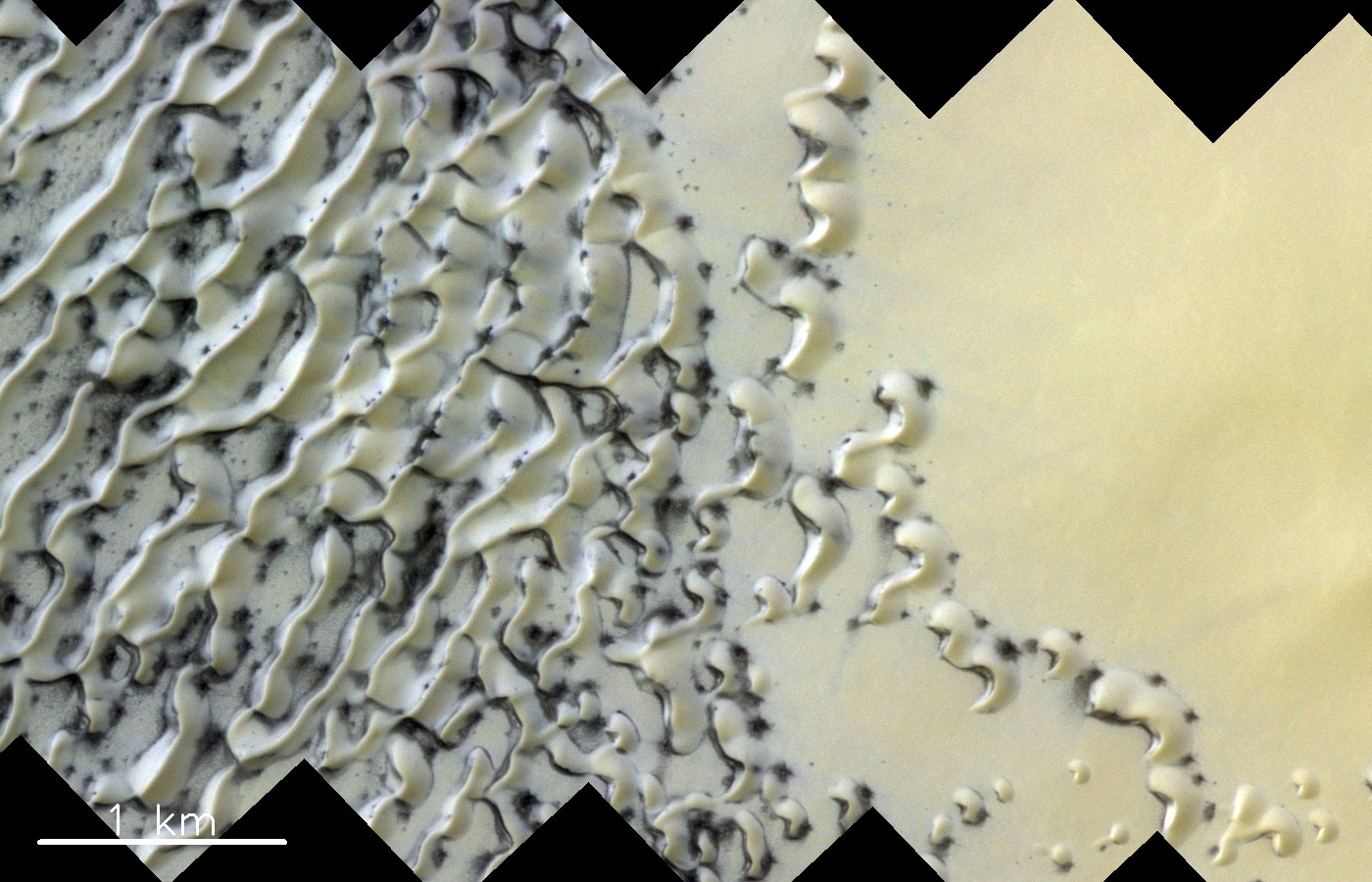
Rippling, dark-flecked sand dunes near Mars' north pole look like melting chocolate-chip ice cream in an image captured by the European-Russian Trace Gas Orbiter spacecraft (TGO).
The photo, which TGO snapped with its Colour and Stereo Surface Imaging System (CaSSIS), shows some effects of springtime warming in the Red Planet's far north.
"During winter in the polar regions, a thin layer of carbon dioxide ice covers the surface and then sublimates — turns directly from ice into vapor — with the first light of spring," European Space Agency (ESA) officials wrote about the image, which was taken May 25 but just released today (Sept. 16).
"In the dune fields, this springtime defrosting occurs from the bottom up, trapping gas between the ice and the sand," they added. "As the ice cracks, this gas is released violently and carries sand with it, forming the dark patches and streaks observed in this CaSSIS image."
Related: Photos: The European-Russian ExoMars Missions to Mars in Pictures
The newly released photo depicts U-shaped "barchan dunes," visible at lower right, meeting up and merging into "barchanoid ridges," ESA officials said.
"The curved tips of the barchan dunes point downwind," the officials added in the same statement. "The transition from barchan to barchanoid dunes tells us that secondary winds also play a role in shaping the dune field."
Get the Space.com Newsletter
Breaking space news, the latest updates on rocket launches, skywatching events and more!
Barchan dunes aren't confined to the Martian poles; NASA's Curiosity rover has also encountered them on the floor of the 96-mile-wide (154 kilometers) Gale Crater, which sits just south of the Red Planet's equator.
TGO launched in March 2016 along with a landing demonstrator called Schiaparelli. Together, the two spacecraft comprised the first phase of the two-part ExoMars program, a collaboration between ESA and Roscosmos, Russia's federal space agency.
Schiaparelli crashed during its landing attempt in October 2016, but TGO arrived safely in orbit around the same time. TGO soon began sniffing the Red Planet's atmosphere for methane — which could be a sign of Mars life, if any has ever existed — and other low-abundance gases.
ExoMars' second phase centers on a life-hunting rover called Rosalind Franklin, which is scheduled to launch toward the Red Planet next summer and land in March 2021. NASA is planning to launch a life-hunting rover of its own during the same window — the 2020 Mars rover, which will get a more memorable name of its own soon via a student naming competition.
- The Sand Dunes of Mars Move in a Weird Way
- Latest News About the ExoMars Missions
- 7 Biggest Mysteries of Mars
Mike Wall's book about the search for alien life, "Out There" (Grand Central Publishing, 2018; illustrated by Karl Tate), is out now. Follow him on Twitter @michaeldwall. Follow us on Twitter @Spacedotcom or Facebook.
Join our Space Forums to keep talking space on the latest missions, night sky and more! And if you have a news tip, correction or comment, let us know at: community@space.com.

Michael Wall is a Senior Space Writer with Space.com and joined the team in 2010. He primarily covers exoplanets, spaceflight and military space, but has been known to dabble in the space art beat. His book about the search for alien life, "Out There," was published on Nov. 13, 2018. Before becoming a science writer, Michael worked as a herpetologist and wildlife biologist. He has a Ph.D. in evolutionary biology from the University of Sydney, Australia, a bachelor's degree from the University of Arizona, and a graduate certificate in science writing from the University of California, Santa Cruz. To find out what his latest project is, you can follow Michael on Twitter.









